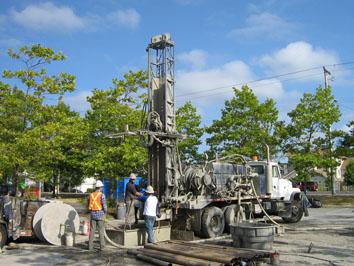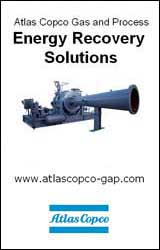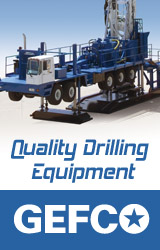Understanding Geoexchange: Heat Pump Technology
By Ruben Arellano, P.Eng. & Michael Schriver, P.Eng.
 Geoexchange, also known as ground-source or geothermal heat pump technology, takes advantage of the abundant low-grade solar thermal energy that’s stored in the ground year-round—free energy under our feet. This energy is captured and delivered by use of a ground-heat exchanger (GHX) and standard heat pump technology.
Geoexchange, also known as ground-source or geothermal heat pump technology, takes advantage of the abundant low-grade solar thermal energy that’s stored in the ground year-round—free energy under our feet. This energy is captured and delivered by use of a ground-heat exchanger (GHX) and standard heat pump technology.
The heat pump is the mechanical device which, through the well-understood vapour-compression refrigeration cycle, readily concentrates low-temperature heat energy into high-grade, useable heat for space heating and hot water heating. The same heat pump can operate in reverse to use the ground as an efficient heat-sink to provide cooling. The heat pump can distribute water for hydronic applications, or distribute forced air with a fan-coil, much like a standard boiler or furnace.
There are many types of GHX, and each is suitable to particular site locations and applications. Ground heat exchangers are commonly one of two broad types: closed-loop or open-loop.
Closed-loop GHX circulates water-based heat transfer fluid through a closed circuit of durable, sealed plastic pipe. As the fluid circulates, it provides low-grade heat from the ground to the heat pump, which then provides heating or cooling as described above. The circuit is typically installed into a number of sealed boreholes, which are drilled up to 500 feet below ground surface. The number of holes depends on the ground formation and energy demand of the building; a typical residence may require two to six holes, while commercial-scale projects may require dozens or hundreds. Some closed-loop systems have the piping laid horizontally in shallow trenches or submerged in ocean, lake, or river water.
Open-loop systems utilize a readily accessible body of water such as the ocean, lake, or, more commonly, a groundwater aquifer. In surface water open-loop, a simple intake and outfall piping system is used to exchange heat with the heat pump. In a groundwater open-loop system, a water supply well is used to pump water out of a suitable aquifer and, most commonly, returned to the same aquifer in another well a suitable distance away.
There are many other types of GHX applied around the world including loops set in foundation piles (energy piles), metal plate heat exchangers (Slim Jims), direct exchange (DX), and more. Only a small amount of electricity is used to operate the system while it extracts and concentrates free energy from the ground, resulting in overall energy efficiency that is 300% to 500% greater than can be achieved with common natural gas or electric equipment. Greenhouse gas emissions are reduced by the same dramatic degree.
The Canadian GeoExchange Coalition reports: “According to information provided by Natural Resources Canada and the US Department of Energy, a typical three-ton (36,000 Btu/hr) residential geoexchange system will produce approximately 450g less carbon dioxide per hour than a conventional system. Therefore, conversion of 100,000 homes to geoexchange systems would produce a reduction in carbon dioxide emissions comparable to converting 58,700 cars to zero-emission vehicles. “
Natural Resources Canada states that “Geoexchange is the most energy efficient, environmentally clean and cost-effective space-conditioning system available on the market today,” and many other authorities agree, including the US Environmental Protection Agency and the Pembina Institute.
Geoexchange systems have been in use for decades, but initially consumers were slow to adopt this technology due to low-energy costs, lack of environmental stewardship and government incentives, and limited equipment options. The past few years have seen exponential growth in the demand for these systems of 40% to 60%, annually. The Canadian GeoExchange Coalition reports there are at least 30,000 residential homes and 6,000 commercial and institutional buildings in Canada with geoexchange systems. These environmentally friendly and efficient systems provide heating, cooling, and domestic hot water for every type of facility imaginable: from single family homes and vacation cottages to towering luxury condominiums and hotels, and from ice sports centres to libraries, schools and supportive housing.
Many incentive programs are now offered by governments and electric utilities to make geoexchange systems even more affordable. The Database of State Incentives for Renewables & Efficiency (www.dsireusa.org) is a source of information on US federal, state, municipal and utility incentives that promote energy efficiency. Natural Resources Canada’s Office of Energy Efficiency Resources provides a similar database.
Since geoexchange systems are not off-the-shelf, completely pre-packaged systems, each system must be specifically assessed, designed, and constructed to suit the particular attributes and objectives of each building or application. This requires a multi-disciplined and multi-stakeholder approach not commonly required with other building elements such as plumbing, electrical, and HVAC. Specialized training and knowledge is required for design and installation. Such training is readily available from national associations in Canada and the States, and several vocational institutions are now offering trades and apprenticeship training programs.
~
GeoExchange BC is a non-profit, industry association of private and public interests. Founded in 2003, its focus is to provide information, education, professional development, training, and resources for the growing geoexchange industry in BC.
Authors
Ruben Arellano, P.Eng. is the chair of GeoExchange BC. He also leads the renewable energy services team at Hemmera, a consultancy based in Vancouver, BC.
Michael Schriver, P.Eng. is a project engineer with XCG Consultants in Toronto, Ontario. He leads XCG’s geoexchange services team on projects in partnership with Hemmera.
GeoExchange BC
http://www.geo-exchange.ca
Hemmera
http://www.hemmera.com
XCG Consultants Ltd. Environmental Engineers & Scientists
http://www.xcg.com
Author: Ruben Arellano, P.Eng. & Michael Schriver, P.Eng.
Volume: July/August 2011




